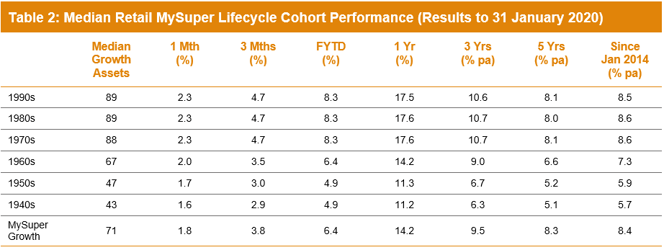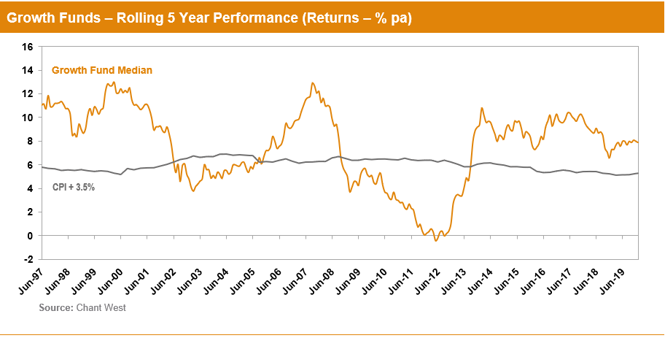After a stellar 2019 when the median growth fund (61 to 80% in growth funds) returned 14.7%, super funds kicked off the new year with an impressive start, returning 1.9% in January. This was on the back of a strong month for Australian shares, local and overseas bonds and the depreciation of the Australian dollar. The momentum has continued into February, too, and we estimate that the median growth fund is up a further 1.5% this month so far.
In January, Australian shares surged 4.9%. International shares, meanwhile, were down 0.4% in hedged terms but the depreciation of the Australian dollar (down from US$0.70 to US$0.67) powered the return to 4.3% in unhedged terms. Listed property was up for the month, with Australian and global REITs gaining 6.3% and 1.3%, respectively.
Chant West senior investment research manager Mano Mohankumar says: "In January, while the domestic share market was strong, global share markets slowed amid mounting fears over the spread of the coronavirus. This resulted in a flight to safely, pushing domestic and global bonds up 2.3% and 1.8%, respectively. Global investors seem to have regained their confidence in February, with both Australian and global share markets recording gains so far.
"So the year has started positively despite some lingering uncertainties. The biggest unknown is the potential spread of the coronavirus and what that might mean in economic terms. Travel and tourism-related businesses are already feeling the effects, as are others with strong trade links to China such as health food exporters. Investors are now weighing up which other sectors may suffer if the contagion continues. Australia is in the forefront here, because not only is China a major export market, it also supplies many parts and finished goods that Australian businesses rely on."
Table 1 compares the median performance for each of the traditional diversified risk categories in Chant West’s Multi-Manager Survey, ranging from All Growth to Conservative. All risk categories are ahead of their long-term return objectives over 1, 3, 5, 7, 10 and 15 years. Those objectives range from inflation plus 2% for the Conservative category to inflation plus 4.75% for the All Growth category.

Note: Performance is shown net of investment fees and tax. It is before administration fees and adviser commissions.
Source: Chant West
Lifecycle products behaving as expected
Mohankumar says, "While our Growth category is still where most people have their super invested, a meaningful number are now in so-called 'lifecycle' products. Most retail funds have adopted a lifecycle design for their MySuper defaults, where members are allocated to an age-based option that is progressively de-risked as that cohort gets older."
It's difficult to make direct comparisons of the performance of these age-based options with the traditional options that are based on a single risk category, and for that reason we report them separately. Table 2 shows the median performance for each of the retail age cohorts, together with their current median allocation to growth assets.

Notes:
1. Performance is shown net of investment fees and tax. It is before administration fees and adviser commissions.
2. January 2014 represents the introduction of MySuper.
Source: Chant West
While lifecycle is the most common MySuper default in the retail sector, most not-for-profit funds still use their traditional growth options as their default investment option. A few not-for-profit funds have gone down the lifecycle path, however, and while the general premise is the same the way it is implemented is different. Rather than allocating members to age-based cohorts as retail funds do, in the not-for-profit lifecycle model members typically ‘switch’ from one traditional risk category to another at particular ages. The diversified options that underlie these strategies are included in Table 1.
To help illustrate the early results of the retail lifecycle model, Table 2 includes a row for traditional MySuper Growth options – mainly, but not all, not-for-profit funds. Care should be taken when comparing the performance of the retail lifecycle cohorts with the median MySuper Growth option, however, as they are managed differently so their level of risk varies over time.
We have mostly seen strong performance from growth assets in recent years so, as we would expect, the options that have higher allocations to growth assets have generally done best. Younger members of retail lifecycle products – those born in the 1970s, 1980s and 1990s – have outperformed the MySuper Growth median over most periods shown. However, they have done so by taking on more share market risk.
The older age cohorts (those born in the 1960s or earlier) are relatively less exposed to growth-orientated assets. Capital preservation is more important at those ages so, while they miss out on the full benefit in rising markets, older members in retail lifecycle options should be better protected in the event of a market downturn.
Long-term performance remains above target
MySuper products have only been operating for six years, so when considering performance it is important to remember that super is a much longer-term proposition. The chart below compares the performance since July 1992 – the start of compulsory superannuation – of the traditional Growth category median with the typical return objective for that category (CPI plus 3.5% per annum after investment fees and tax over rolling five-year periods). The healthy returns since the end of the GFC in early 2009 have seen the longer-term performance tracking well above that CPI plus 3.5% target for the past six years.

Note: The CPI figures for January 2020 is an estimate.
International share market returns in this media release are sourced from MSCI. This data is the property of MSCI. No use or distribution without written consent. Data provided “as is” without any warranties. MSCI assumes no liability for or in connection with the data. Product is not sponsored, endorsed, sold or promoted by MSCI. Please see complete MSCI disclaimer.



